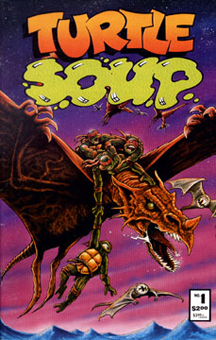“Shell Shock” (1989), which I reviewed in my last post, is the most significant collection of TMNT shorts from Mirage “Teenage Mutant Ninja Turtles” Volume 1, as it gathers up 26 of them. Next up for a Turtle fan looking to read all the shorts should be five issues of “Turtle Soup” (Volume 1, No. 1 from 1987; and Volume 2, Nos. 1-4 from 1991-92) and Michael Dooney’s “Challenges” (1991).
“Turtle Soup” Vol. 1 No. 1
The lone black-and-white issue of “Turtle Soup” suffers from its lack of Eastman & Laird works, as every entry is by a guest artist. Steve Bissette’s “Turtle Dreams” (not to be confused with Matt Howarth’s Issue 41, titled the same) is a deliciously dark piece that explores the violence inherent in the Turtles’ lives, as Michaelangelo suffers a serious injury. It’s odd that a story this deep is just a one-shot standalone, not to be expanded anywhere else.
“Usagi Yojimbo” creator Stan Sakai has his anthropomorphic samurai rabbit meet Leonardo in “Turtle Soup and Rabbit Stew.” (Interestingly, Sakai wrote this crossover in a TMNT title, and Peter Laird wrote a crossover in an “Usagi” title.)

“Turtle Soup” (1987, 1991-92)
Writers: Steve Bissette, Frank Bella, Stan Sakai, Eric Talbot, Jim Miller, C.A. Stormon, Francis Mao, Bernie Shuman, Danny Shuman, John Dowling, Mark Martin, Michael Dooney, Steve Lavigne, J.B. Bonivert, Rick McCollum, Bill Anderson, Jim Woodring, Rick Arthur, Justin Hampton, Rich Hedden, Tom McWeeney, Dave Garcia, Don Simpson, Peter Laird, Mary Kelleher, Mary Woodring, A.C. Farley, Richmond Lewis, Mark Thibodeaux, Jack Kirby, Guy Romano, Michael Zulli, Steve Murphy, Rob Caswell, Michael R. Gaydos, Dan Berger
It’s too inexplicable that Leo just “pops” into and out of Usagi’s world; Renet’s scepter seems logical by comparison. But it’s a fun story that paves the way for many more Leo-Usagi meet-ups in the comics and cartoons. (Plus, Usagi got two action figures in the original Playmates line.)
Eric Talbot’s horror yarn “The Howl” is the only story duplicated in “Turtle Soup” and “Shell Shock.” The other entries in this first “Turtle Soup” issue are hardly worth mentioning, except that they’re so bizarrely off-point. Bernie Shuman’s “You’re In the Army Now” is the prime example: It’s an overlong joke about Leo and Don mistakenly being swept up in basic training; it’s not funny and none of the characterizations are accurate.
“Turtle Soup” Vol. 2
“Turtle Soup” resurfaced four years after the first installment as Mirage – for better or worse – became infatuated with color. First Publishing had adapted Issues 1-11 and “Leonardo” into color volumes, two Mark Bode comedy stories (Issues 18 and 32) had color versions (and his 1992 special, “Times Pipeline,” was only available in color), and Issue 33 was only available in color.
“Turtle Soup” Volume 2 (1991-92) was the first all-color title, preceding Volume 2 of the main title, which started in 1993.
“Turtle Soup” Volume 2 lasted only four issues (or “Books,” as they are dubbed), and because Dooney’s “Teenage Mutant Ninja Turtles Attack!!!” runs across all four and is featured in the cover art of each, and because Mark Martin highlights each of his Turtles in a “Green-Grey Sponge-Suit Sushi Turtles” solo short, one would assume the title was intended to last four issues.
But I don’t know that for sure. Certainly, “Turtle Soup” Volume 2 marked the end of the guest-author era, so it makes sense that it ended at the same time Mirage brought the main title back in-house for Issue 45.
Several of the “Turtle Soup” Volume 2 shorts expand upon issues from the main title. Rick McCollum’s “Donatello: The Ring” (in Book 1) shows Don meeting the giant Turtle god that he was so intent on showing to his brothers in Issue 37.
Seemingly continuing his look at each of the Turtles, McCollum delivers “Raphael: Snapper” (Book 2), which finds Raphael falling asleep after eating too many pizzas (six, to be exact) and having a nightmare that April’s pet snapping turtle attacks him. (Before reading it, I assumed the title referred to Raph himself.)
Nightmares were a common theme of TMNT shorts, dating back to Bissette’s “Turtle Dreams.” Also, Don dreamed of getting fat in Issue 41, and Mike was haunted by an armchair and movie monsters in separate “Shell Shock” yarns.
And in Mark Thibodeaux’s “Teenage Mutant Ninja Turtle” (Book 4), Mike dozes off while reading a “Viking Heroes” comic and dreams of fighting a monster on the high seas. Also of interest, Thibodeaux draws the Turtles with nostrils, a choice that was harmless in this short but highly controversial when worked into the design for the upcoming big-screen TMNT reboot.
It might’ve been neat to see what McCollum had planned for Leo and Mike, but he drops the pattern and features all four in “Bearing the Burden” (Book 3), where the Turtles mentally gear up for battle.
On the last page, we get the punchline that they were actually bracing themselves for Splinter to give them a shell fungus inoculation, but nonetheless, it’s neat to see that Raph likes facing battle alone, Leo gladly accepts facing battle alone, Don reluctantly will face battle alone, and Mike will do whatever Splinter asks of him.
A Raph short that’s superior to McCollum’s is A.C. Farley’s “Crack in a Cold Heart” (Book 3). Raph is off by himself in the woods, working himself into a depression by imagining Splinter dying. Mike finds him, Raph admits his feelings, Mike gives him a pep talk and Raph mutters “That guy can be such a doofus!”
It’s a spot-on portrayal of Raph and how Mike is the only brother who can bring him out of his shell (metaphorically). Perhaps this would fit nicely on the timeline between “Return to New York” and “The River,” when Raph was going through pointed mood swings.
Farley again steals the show in Book 4 with “Fifteen Years Later …” We learn that Chet, the kid whose bowl of turtles was knocked into the sewer in the Issue 1 flashback, worried about the fate of his pets to the point where he went into the sewer-maintenance business! “Do I know you?” Raph says, eyes wide, and Chet realizes these are his pets, and they turned out fine.
The Turtles flee in fear of being found out, but of course, Chet is no threat to them. It’s the latest of numerous examples of the writers’ inconsistent stance on whether the Turtles should remain hidden (although, to be fair, this story probably takes place before they meet April).
In later stories, they have no qualms about mixing with humans (with exceptions made for cops – other than Nobody — and reporters). Rick Arthur’s “The Name is Lucindra” (Book 1) is a prologue to Issue 44, but not a particularly strong one. It’s just Raph and his pal Lucindra fighting, and – as with Issue 44 – the human fighter gets the best of the ninja turtle, who is wimpily wearing sparring pads here.
Lucindra never made much sense: Raph already had a buddy outside of his brothers (Casey Jones) with whom he could let out his aggressions. Maybe Arthur was aiming for at some sort of love story between Raph and Lucindra, but that never rises to the surface.
A more interesting female character is timestress Renet, although you won’t find much depth in Jim Lawson’s “Sweat, Sweat, Sweet Renet” (Book 3). It takes place within “Tales” 7, when the Turtles go millions of years into the past; “Shell Shock” also features one of these dinosaur-times shorts. It’s a harmless three-pager of Renet climbing up a mountainside dodging various beasts, and Leo’s punchline of “Do you think we shoulda told her about the shortcut?”
There’s too much lightness in “Turtle Soup” Volume 2 for my taste. Dooney’s art is the only reason to read the overarching tale, “Teenage Mutant Ninja Turtles Attack!!!” Well, that and the odd revelation that the Turtles can go out to dinner in Florence, Mass., and apparently the local humans aren’t bothered by the existence of four mutant turtles.
I keep forgetting that the girl on the cover of Books 1 and 3 is Betti, an accidental time-traveler from the future, and not a particularly sexy incarnation of April (she had a wide range of looks, depending on the artist). And unabashed comedy writers Martin, Hedden & McWeeney and Don Simpson take up too much of the “Turtle Soup” page count for my taste.
“Challenges”
In my opinion, “Turtle Soup” should’ve been more like “Challenges,” a black-and-white, smaller-format book where Dooney explores each of the Turtles plus the oft-overlooked Splinter in five vignettes, striking a nice tonal balance between depth and lightness.
Donatello is (metaphorically) trapped in a computer fighting game. (Mike got literally sucked into Don’s computer in a “Shell Shock” short.) Leonardo does a “Rocky” workout montage in the barn, but it has a nice punchline where Raph calls Leo out for signing him up for the Barry Manilow fan club; the serious leader has a sense of humor!

“Challenges” (1991)
Writer: Michael Dooney
Artist: Michael Dooney
The other three vignettes have a bit more to them: We learn that Splinter is still the master, as he defeats Raph in one-on-one combat. Michaelangelo apprehends a couple of poachers, showing that the “nice Turtle” can be pushed over the edge if it’s something he believes in. And Raphael’s is the sweetest yarn, as Raph gets roped into cleaning out a basement for an old blind woman (who naturally assumes he’s a human teenager), and ends up enjoying her company.
While there weren’t any concerted efforts to give the Turtles distinct personalities and traits early in Mirage’s run (even some of the one-shots were thin on characterization), by 1991 we certainly had a good sense of who Leo, Raph, Mike and Don were. (Splinter, April and Casey would then get their due in 1992’s “City at War.”)
“Challenges” solidifies these personalities, and affirms what a fine job the Mirage crew had done – organically or accidentally — in shaping the four Turtles with bits and pieces of characterization here and there.


